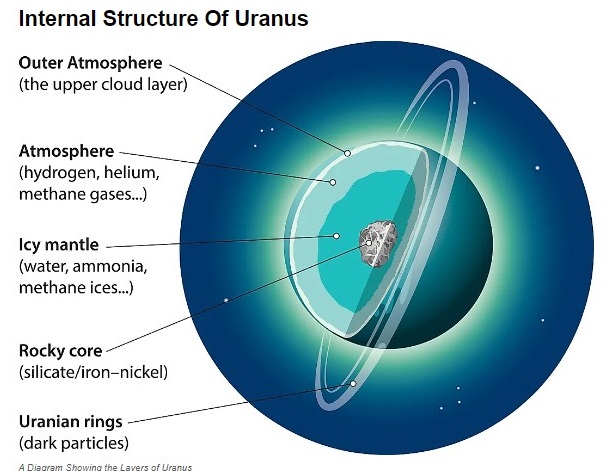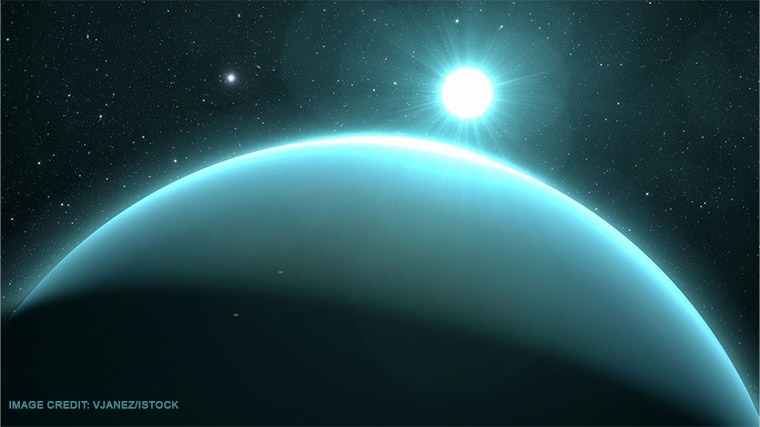Uranus, one of the massive gas giants, ranks third in size among the planets. It is four times wider than the Earth, and its diameter is 51,118.20 km. But it is the second least dense planet in the solar system. Gravity there is only 90% of Earth’s. Uranus stands out for its smooth and simple surface compared to other rocky or chaotic planets. The blue color that turns into green is due to the composition of gases and the characteristics of the atmosphere.
Uranus is a Neptune-like ice giant with a complex hydrogen and helium atmosphere. The atmosphere also contains methane and other hydrocarbons, and clouds of ice, ammonia, and hydrogen make its atmosphere unique. Uranus stands out as having the coldest atmosphere among the planets in the solar system, where temperatures can drop to -224 °C. Its unique blue-green hue, visible from Earth, results from the presence of methane in the atmosphere.
A False Color Image Taken by Voyager 2 of Uranus’ Atmosphere, and How the Latter Circulates in the Same Direction as the PlanetCredit: NASA/JPL
In 2018, the composition of the upper layers of the Uranian atmosphere was determined using the NIFS spectrograph. It turned out that the clouds in this layer consisted of frozen hydrogen sulfide. This same substance gives rotten eggs their unique “flavor.”
The presence of this substance in the planet’s upper layers indicates that Uranus was not formed in the orbit in which it is now. Like all giant planets, it was born closer to the Sun and migrated to its present location in the first tens of millions of years.
The internal composition of Uranus includes mountainous and glacial materials. The gas core consists mainly of hydrogen and helium, making up 80% of the planet’s mass. The radius of the core reaches 20% of the planet’s radius. It is believed that Uranus lost part of its core when it collided with another object and turned over on its side.

A Diagram Showing the Layers of Uranus. Credit: Worldatlas.
Uranus’ magnetic field is offset nearly 60 degrees from its poles, creating a more robust field at one pole than the other. This magnetic field arrangement is possible due to the impact of the collision. Scientists believe that the core of Uranus does not control the magnetic field, unlike the Earth. Uranus’ magnetic field tumbles quickly, like a child rolling down a hill. When it encounters the solar wind, its magnetic field opens and closes. This happens daily.
Uranus’ magnetic field. Credit: NASA/Scientific Visualization Studio/Tom Bridgman
The radius of the core reaches 20% of the planet’s radius. The mantle’s significant content of ice, such as water, ammonia, and methane, distinguishes Uranus from other gas giants.
There are several rocky rings around Uranus’ equator. These narrow rings, only a few miles wide, are formed from tiny particles of rock and ice, each less than a meter in size. The planet has 13 known rings. The outer ring of Uranus glows bright blue. This is due to his companion Mab.
Regarding weather, Uranus only has two seasons, as the sun illuminates one pole of the planet for 42 years and the other for the next 42 years. The ocean on Uranus is unique, consisting of water and ammonia liquefied by the atmosphere. The high electrical conductivity of this ocean makes it dangerous.
Compared to other gas giants, Uranus is characterized by a large amount of ice due to its distance from the sun. It is assumed that Uranus and Neptune formed in another region of the solar system, where conditions were more favorable for the formation of ice and rocks.
Banner image: Credit: Shutterstock/ Elements of this image furnished by NASA.
Image credit:
https://www.worldatlas.com
https://www.jpl.nasa.gov
https://www.worldatlas.com
https://www.jpl.nasa.gov


